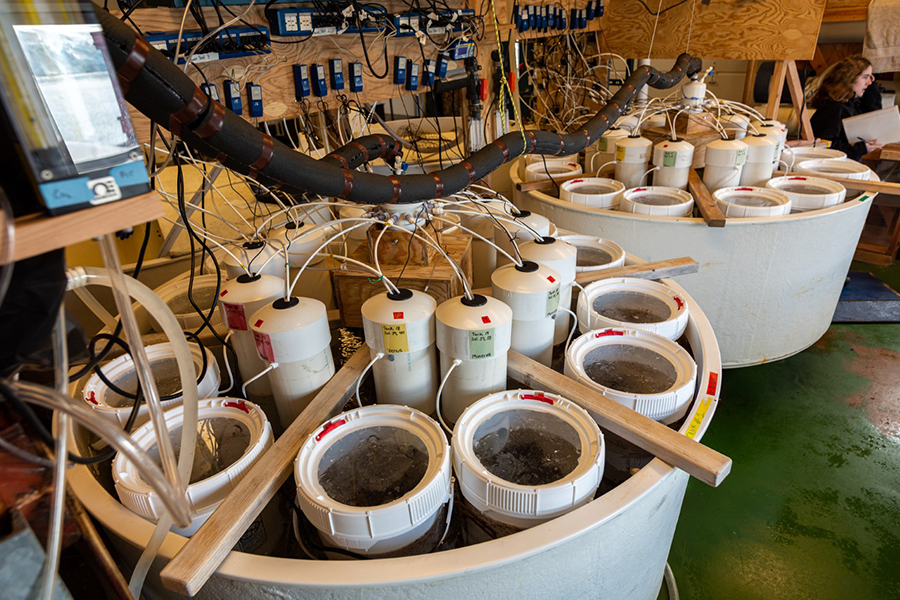Facing the Ultimate Acid TestHow Will Antarctic Amphipods Handle a Dramatically Changing Ocean?Posted May 11, 2020
Some of the Southern Ocean's smallest animals are facing big challenges. 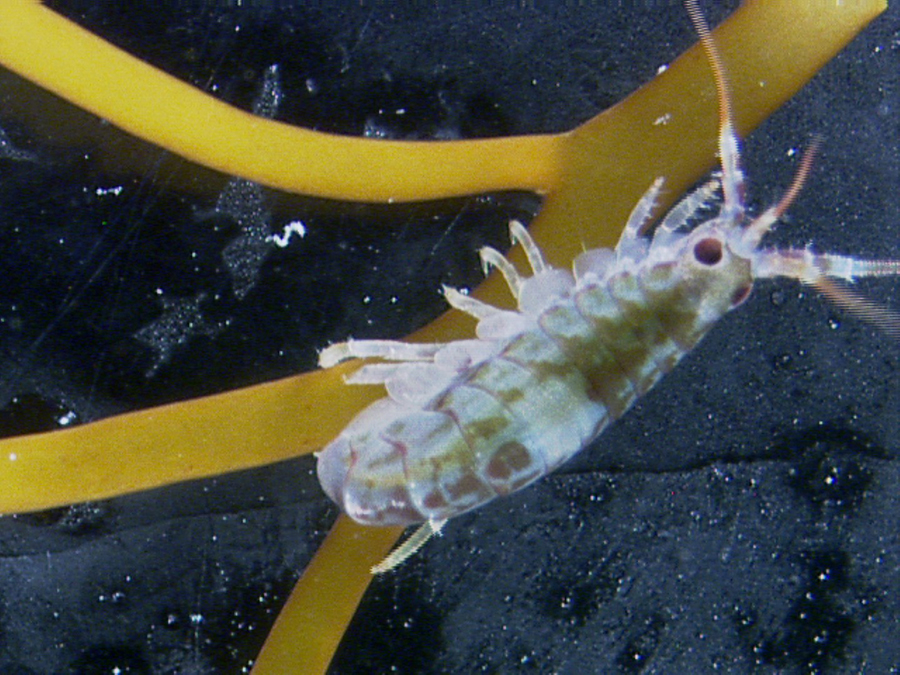
Photo Credit: Maggie Amsler
Gondogeneia antarctica is one of the main species of amphipods living in the ocean waters around Palmer station.
The once-exceedingly stable Southern Ocean around Antarctica is warming, and as it absorbs carbon dioxide from the atmosphere, it is also growing more acidic. Creatures large and small living there will have to adapt to the new conditions, but inevitably there will be winners and losers as the ocean changes along with the planet's climate. Scientists in Antarctica are investigating the possible fate of marine amphipods, which are tiny crustaceans, just barely big enough to see. Though tiny, the many species occupy important niches in ecosystems the world over, as they are consumers of algae and plankton, and themselves are food for larger fish and invertebrates. "We're trying to understand the impact of ocean acidification on some very important members of the shallow-water marine communities," said Charles Amsler, a biologist at the University of Alabama at Birmingham and co-principal investigator on the project. Previous research hinted that changing ocean conditions could threaten the ability of marine amphipods to thrive in Antarctic waters as the historically stable waters warm and acidify, so Amsler and his team of scientists traveled to Palmer Station to study the effects of the predicted changing water chemistry on these critters. "I think there is some justification for looking at Antarctic acidification," said James McClintock, an ecologist at the University of Alabama at Birmingham and co-principal investigator on the project. "There's a paucity of studies on ocean acidification for Antarctica." 
Photo Credit: Kate Schoenrock
Chuck Amsler (left) talks with Maggie Amsler as he prepares to scuba dive to collect amphipods near Palmer Station.
The project is supported by the National Science Foundation, which manages the U.S. Antarctic Program. Underwater Forest Communities"You wouldn't think there are forests out there but there are," Charles Amsler said. "Seaweeds, or 'macroalgae,' form these enormous forests… They support huge numbers of these tiny little shrimp-like animals." The two groups of organisms – macroalgae and amphipods – have forged mutually beneficial relationships in the frigid Antarctic waters. The amphipods that call the seaweeds home don't eat them, but instead scour the surfaces of the algal blades clean of smaller species. This rids the seaweeds of organisms that might otherwise eat the blades or reduce the light and nutrients the blades need to grow. In turn, the amphipods are protected from predators by the natural defenses of the seaweeds. "The seaweeds are chemically defended, so fish that would like to eat the amphipods don't like to eat the amphipods if they're living on these seaweeds, because they get a mouthful of nasty seaweeds," Charles Amsler said. It's a kind of close symbiosis on a scale that is unlike anything else seen on the planet. Amphipods, which generally resemble very tiny shrimp, are ubiquitous throughout the waters off the coast of Antarctica. There are, by some estimates, hundreds of thousands of them living in a single square meter of the water column. 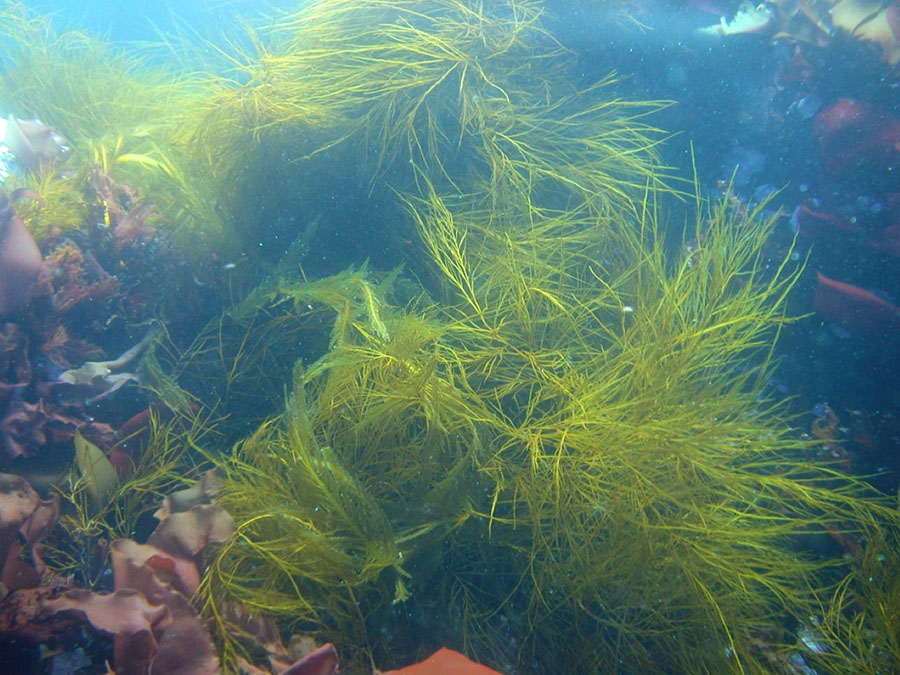
Photo Credit: Bill Baker
Amphipods grow on large brown algae of the genus Desmarestia and smaller red macroalgaes in the waters near Palmer Station.
"The importance of amphipods in this macroalgal community is unique," McClintock said. "The high abundances here are not found up in temperate tropical systems so it is a uniquely Antarctic phenomenon." Though the research team is focusing on amphipod species that live on the seaweed, numerous other species that fill different roles in the ecosystem. "[Amphipods] serve a couple of niches," said Maggie Amsler, an ecologist at the University of Alabama at Birmingham. "There are some that specialize on feeding on dead material, some that specialize on feeding on sediment and detritus and there are some that feed on critters growing on the macroalgae." Despite their importance to the health of the marine ecosystem, there's been relatively little research done on the effects of ocean acidification on these crustaceans. Their abundance in these Antarctic seaweed forests makes it the ideal place to study how different species are likely to react to changing ocean conditions and allow scientists to extrapolate what they find to communities around the world. "Amphipods are really important in lots of communities in the world but there's been relatively little work done on ocean acidification," Charles Amsler said. "There is a globally relevant component to this, in addition to the really important understanding how Antarctic communities function." 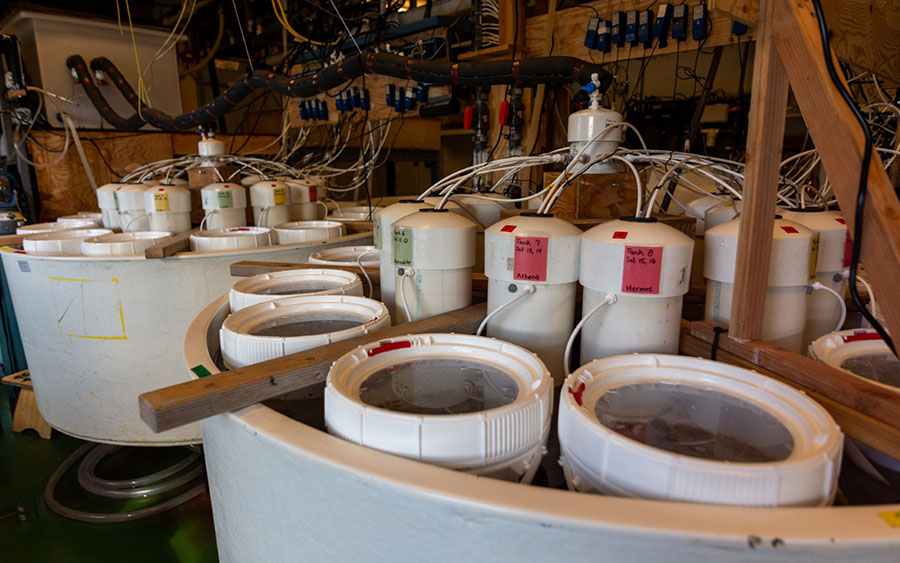
Photo Credit: Mike Lucibella
In Palmer Station's aquatic lab, numerous tanks contain different species of amphipods under different simulated future ocean conditions.
Aggressive Water ChemistryAs the level of carbon dioxide increases in the atmosphere, more will mix into the oceans, causing the oceans to acidify. This is a particularly acute problem in the frigid Antarctic waters because cold liquids absorb gasses from the atmosphere more efficiently than warmer waters. To see what's likely to happen to the amphipods over the coming decades, the team is testing how different species react to ocean waters at different points on the pH scale. The pH scale, which ranges from 0 to 14, measures how acidic or basic a substance is. Something extremely acidic is 0, lemon juice is 2, a neutral substance is 7, while bleach is very basic at around 13 on the scale. The research team is having amphipods live in waters ranging from current conditions, or about 8.1 on the pH scale, to the pH predicted for the oceans at the end of this century level of about 7.7 all the way to an extreme level of 7.3 on the scale. "The difference doesn't seem like very much, you're only going down 0.4 or whatever, but it is a logarithmic scale so that's a huge difference," said Hannah Oswalt, a PhD student at the University of Alabama at Birmingham. "If you go down one point on the logarithmic scale, that's 10 times more acidic. So it's a really big difference even though on paper it may not look like a huge difference." This year the team collected amphipods from numerous dive sites near Palmer Station. 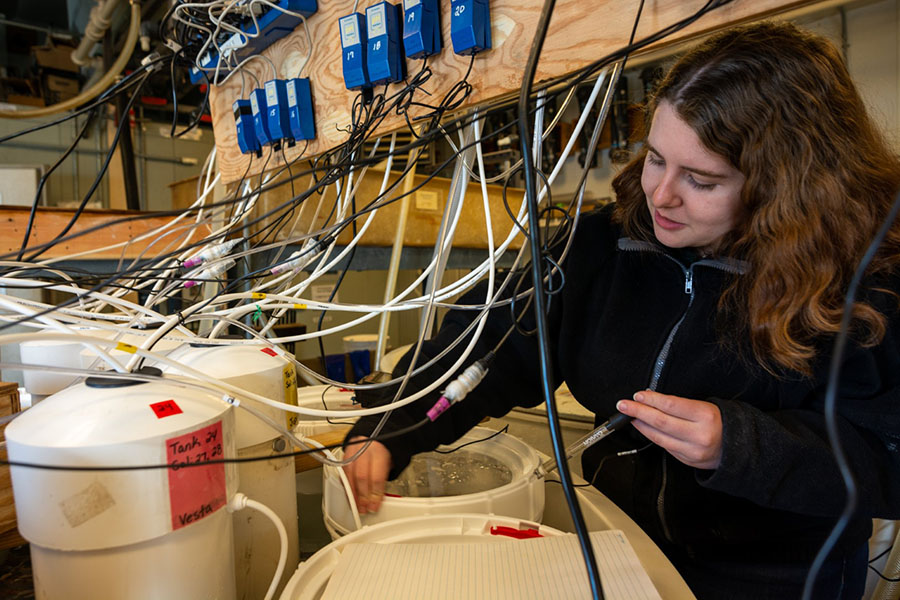
Photo Credit: Mike Lucibella
Hannah Oswalt checks the temperature of the tanks containing the amphipods within.
"We did collect from five different spots. Unfortunately, this year compared to other years there's not as much diversity in the community and we don't know why," Charles Amsler said. "The numbers are high, but the species diversity is just not as high." From the species they collected they want to see which ones are able to cope best with the changing ocean conditions, and which ones were the most vulnerable. "This year is just 'who are the winners and losers,' and next year trying to get a couple [species] that did relatively well and a couple that did relatively poorly and we will be looking at calcification of their exoskeletons," Charles Amsler said. The acidity of ocean water affects the ability of organisms to pull dissolved calcium out of the water and properly form their hard, protective outer shells. As the ocean becomes more acidic, it is more difficult. However, there seem to be other ways that the acidification impacts these amphipods, especially when they’re in times of heightened stress, like when they're shedding their outgrown exoskeletons. "You put them under near-future ocean acidification conditions and right about the time they started to molt, they started to die," Charles Amsler said. So far, it’s not clear exactly why they're dying when they molt, but it's something the researchers are planning on investigating more carefully next year. Based on what they've seen from experiments so far, Maggie Amsler has a theory. 
Photo Credit: Mike Lucibella
The researchers monitor the health of the amphipods living on algae in the different tanks simulating different possible future ocean conditions.
"A lot of the ones that died during molting got stuck while they were trying to get out [of their shells,]" she said. "Crustaceans, in general, have ridiculous segmentation and appendages and all sorts of specialized sculpting of those appendages and how they manage to get themselves out usually with just one break in that exoskeleton, is a Houdini feat to be sure. Any variation from the norm I think could really alter their gymnastic ability to get out of that." The team finished their field experiments at Palmer Station in late March, and are now analyzing the data they collected on the relative health of different the amphipod species in preparation for returning next year. NSF-funded research in this story: James McClintock and Charles Amsler, University of Alabama at Birmingham, Award No. 1848887. |



For USAP Participants |
For The Public |
For Researchers and EducatorsContact UsU.S. National Science FoundationOffice of Polar Programs Geosciences Directorate 2415 Eisenhower Avenue, Suite W7100 Alexandria, VA 22314 Sign up for the NSF Office of Polar Programs newsletter and events. Feedback Form |

